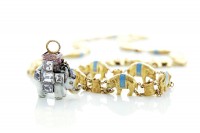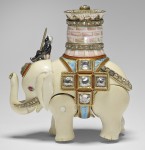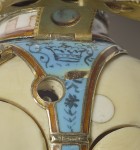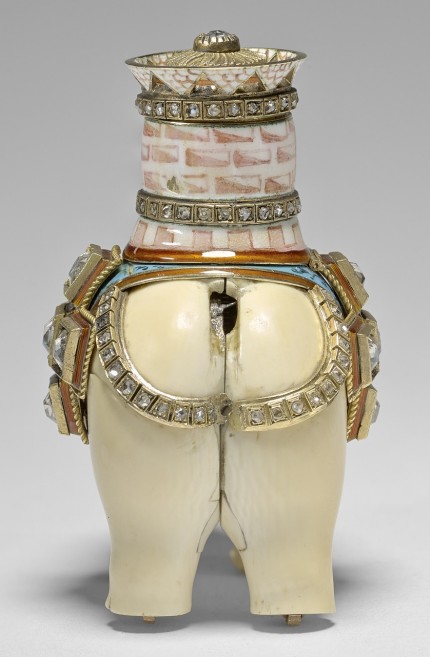 An imperial Fabergé egg will be reunited with its original surprise for the first time since the 1920s in a new exhibition at the Houston Museum of Natural Science (HMNS). Made of a translucent celadon stone and crisscrossed with a trellis pattern of rose-cut diamonds, the Diamond Trellis Egg is part of the McFerrin Fabergé Collection, the largest private collection of Fabergé treasures in the world, which is housed in the HMNS. The surprise inside, a jeweled ivory elephant wind-up automaton, was recently rediscovered in the Royal Collection and has been loaned to the museum by Queen Elizabeth II.
An imperial Fabergé egg will be reunited with its original surprise for the first time since the 1920s in a new exhibition at the Houston Museum of Natural Science (HMNS). Made of a translucent celadon stone and crisscrossed with a trellis pattern of rose-cut diamonds, the Diamond Trellis Egg is part of the McFerrin Fabergé Collection, the largest private collection of Fabergé treasures in the world, which is housed in the HMNS. The surprise inside, a jeweled ivory elephant wind-up automaton, was recently rediscovered in the Royal Collection and has been loaned to the museum by Queen Elizabeth II.
 Presented by Tsar Alexander III to his wife the Empress Maria Feodorovna (née Princess Dagmar of Denmark) for Easter in 1892, the Diamond Trellis Egg held an elephant surprise that was a virtually identical replica of the badge of the Order of the Elephant, Denmark’s highest chivalric order. The only differences are the materials — Fabergé used ivory instead of white enamel — and the automaton mechanism. It was the second egg Alexander commissioned for his wife to have a Danish theme. The first was the Danish Palaces Egg, presented to Maria Feodorovna on Easter, 1890. The surprise inside was a ten-panel folding screen with miniatures of the Tsarina’s favorite Danish and Russian palaces. After Alexander’s sudden death in 1894 at the age of 49, his son Tsar Nicholas II continued the tradition of Fabergé Easter eggs, gifting them to both his wife and to his mother. It was Nicholas who gave the Dowager Empress her third and last Danish egg, the Royal Danish Egg, now lost.
Presented by Tsar Alexander III to his wife the Empress Maria Feodorovna (née Princess Dagmar of Denmark) for Easter in 1892, the Diamond Trellis Egg held an elephant surprise that was a virtually identical replica of the badge of the Order of the Elephant, Denmark’s highest chivalric order. The only differences are the materials — Fabergé used ivory instead of white enamel — and the automaton mechanism. It was the second egg Alexander commissioned for his wife to have a Danish theme. The first was the Danish Palaces Egg, presented to Maria Feodorovna on Easter, 1890. The surprise inside was a ten-panel folding screen with miniatures of the Tsarina’s favorite Danish and Russian palaces. After Alexander’s sudden death in 1894 at the age of 49, his son Tsar Nicholas II continued the tradition of Fabergé Easter eggs, gifting them to both his wife and to his mother. It was Nicholas who gave the Dowager Empress her third and last Danish egg, the Royal Danish Egg, now lost.
 The Diamond Trellis Egg and its elephant were confiscated from the Anichkov Palace in St. Petersburg, Maria Feodorovna’s home base, by the Bolsheviks in 1917. It was sold in 1930 by the Antikvariat, the agency tasked with selling off Russia’s cultural patrimony to raise money for the Soviet government, probably to Emanuel Wartski, although there are no records of the sale.
The Diamond Trellis Egg and its elephant were confiscated from the Anichkov Palace in St. Petersburg, Maria Feodorovna’s home base, by the Bolsheviks in 1917. It was sold in 1930 by the Antikvariat, the agency tasked with selling off Russia’s cultural patrimony to raise money for the Soviet government, probably to Emanuel Wartski, although there are no records of the sale.
At some point in the saga the three parts of the egg, the base (now lost), the elephant and the egg got separated. In 1935 King George V bought the little elephant without knowing it was part of an Imperial Egg or even that it was made by Fabergé. It has been in the Royal Collection ever since, on display in one of the state rooms for decades.
 In 2015, Caroline de Guitaut, Senior Curator of the Royal Collection Trust, was cataloguing the collection when she noticed the elephant figurine bore a resemblance to the surprise in the Diamond Trellis Egg as described in Fabergé’s ledgers: “ivory figure of an elephant, clockwork, with a small gold tower, partly enamelled and decorated with rose-cut diamonds,” with “a black mahout…seated on its head.” The Trust’s restorers and clockmakers painstakingly took the elephant apart down to the internal mechanism. They finally found the confirmation of the figurine’s origin under the top part of the castle on the elephant’s back. There was the unmistakable hallmark of Carl Fabergé.
In 2015, Caroline de Guitaut, Senior Curator of the Royal Collection Trust, was cataloguing the collection when she noticed the elephant figurine bore a resemblance to the surprise in the Diamond Trellis Egg as described in Fabergé’s ledgers: “ivory figure of an elephant, clockwork, with a small gold tower, partly enamelled and decorated with rose-cut diamonds,” with “a black mahout…seated on its head.” The Trust’s restorers and clockmakers painstakingly took the elephant apart down to the internal mechanism. They finally found the confirmation of the figurine’s origin under the top part of the castle on the elephant’s back. There was the unmistakable hallmark of Carl Fabergé.
 When the cleaned and restored elephant was put back together, curators were ecstatic to find that the mechanism still worked. They slid the key into the hole hidden under the diamond cross on the elephant’s side, wound it up, and the little guy walked and nodded his head like he’d never lived through war, revolution and separation from his home egg.
When the cleaned and restored elephant was put back together, curators were ecstatic to find that the mechanism still worked. They slid the key into the hole hidden under the diamond cross on the elephant’s side, wound it up, and the little guy walked and nodded his head like he’d never lived through war, revolution and separation from his home egg.
The reunited egg and elephant will help inaugurate the Houston Museum of Natural Science’s new gallery dedicated to the Artie and Dorothy McFerrin Collection and its whopping 600 pieces of Fabergé. Fabergé: Royal Gifts featuring the Trellis Egg Surprise opens April 10th. The elephant will be on loan for a year before returning to the Royal Collection.
There are some beautiful views of the glittering egg and surprise in this brief video in which Caroline de Guitaut and Joel Bartsch, President of the Houston Museum of Natural Science, discuss the discovery of the missing piece. There’s an all too brief glimpse of the elephant’s movement at the 1:57 mark.
This video from the Royal Collection Trust, on the other hand, shows nothing but the automaton’s motion, starting with the wind-up. He raises his head every few steps. It’s absurdly cute.
Oh hey, guess what?
